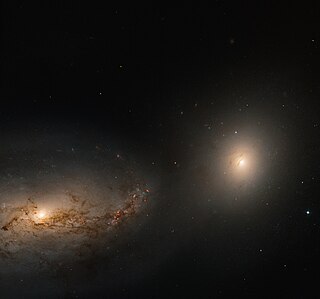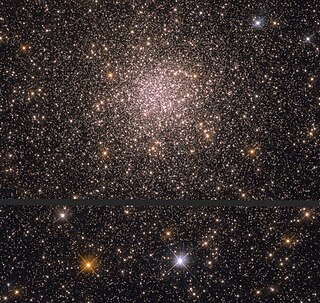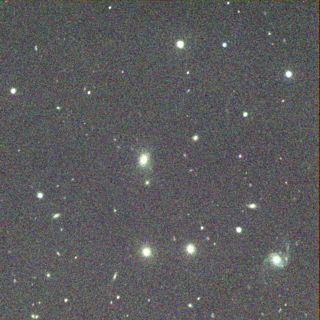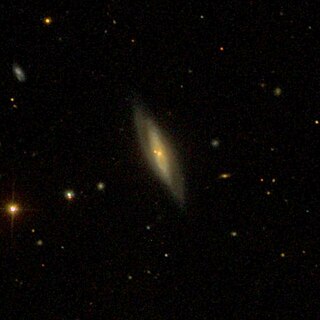
NGC 3227 is an intermediate spiral galaxy that is interacting with the dwarf elliptical galaxy NGC 3226. The two galaxies are one of several examples of a spiral with a dwarf elliptical companion that are listed in the Atlas of Peculiar Galaxies. Both galaxies may be found in the constellation Leo. It is a member of the NGC 3227 Group of galaxies, which is a member of the Leo II Groups, a series of galaxies and galaxy clusters strung out from the right edge of the Virgo Supercluster.

NGC 6316 is a globular cluster located in the constellation Ophiuchus. Its Shapley-Sawyer Concentration Class is III, meaning that it has a "strong inner core of stars" and was discovered by the German-born British astronomer William Herschel on 24 May 1784. It is at a distance of about 37,000 light years away from the Earth. NGC 6316 has a metallicity of -0.45, although new studies suggest this cluster to be more metal Poor, with a metallicity of -0.87 and -0.9; this means that its ratio of hydrogen/helium to other elements is only 35% that of the Sun, but still enough to be considered a "metal-rich" globular cluster.

NGC 1792 is a spiral galaxy located in the southern Columba constellation. It was discovered by Scottish astronomer James Dunlop on October 4, 1826. This galaxy is located at a distance of about 36.4 million light-years and is receding from the Milky Way with a heliocentric radial velocity of 1,208 km/s. NGC 1792 is a member of the NGC 1808 cluster of galaxies.

NGC 243 is a lenticular galaxy located in the constellation Andromeda. It was discovered on October 18, 1881 by Édouard Stephan.

NGC 267 is an open cluster in the Small Magellanic Cloud. It is located in the constellation Tucana. It was discovered on October 4, 1836, by John Herschel.

NGC 274 is a lenticular galaxy in the constellation Cetus. It is a pair of galaxies, the other being NGC 275, which it is currently interacting with. It was discovered on September 10, 1785 by William Herschel. It is roughly 120 million light-years away.

NGC 283 is a spiral galaxy in the constellation Cetus. It was discovered on October 2, 1886, by Francis Leavenworth.

NGC 285 is a lenticular galaxy in the constellation Cetus. It was discovered on October 2, 1886, by Francis Leavenworth.

NGC 286 is a lenticular galaxy in the constellation Cetus. It was discovered on October 2, 1886 by Francis Leavenworth.

NGC 297 is an elliptical galaxy in the constellation Cetus. It was discovered on September 27, 1864, by Albert Marth and is classified as type E3, based on galaxy morphological classification.

NGC 304 is a lenticular galaxy in the constellation Andromeda. It was discovered on October 23, 1878, by Édouard Stephan.

NGC 327 is a spiral galaxy in the constellation Cetus. It was discovered on September 27, 1864 by Albert Marth. It is described by Dreyer as "faint, small, extended." It is nearby galaxies NGC 329, NGC 325 and NGC 321.

NGC 333 is a lenticular galaxy located approximately 755 million light years away in the constellation Cetus. It was discovered in 1877 by Wilhelm Tempel. It is recorded as NGC 333 in the New General Catalogue. It has a companion galaxy, named PGC 3073571, which is presumed to be a physical pair with NGC 333.

NGC 353 is a spiral galaxy in the constellation Cetus. It was discovered on November 10, 1885 by Lewis Swift. It was described by Dreyer as "extremely faint, pretty small, round, southeastern of 2.", the other being NGC 351.

NGC 359 is an elliptical galaxy located approximately 238 million light-years from the Solar System in the constellation Cetus. It was discovered on September 2, 1864, by Albert Marth. It was described by Dreyer as "extremely faint, very small."

NGC 364 is a barred lenticular galaxy in the constellation Cetus. It was discovered on September 2, 1864, by Albert Marth. It was described by Dreyer as "very faint, very small."

NGC 375 is an elliptical galaxy located in the constellation Pisces. It was discovered on September 12, 1784 by William Herschel. It was described by Dreyer as "pretty faint, small, round, brighter middle." Along with galaxies NGC 379, NGC 380, NGC 382, NGC 383, NGC 384, NGC 385, NGC 386, NGC 387 and NGC 388, NGC 375 forms a galaxy cluster called Arp 331.

NGC 3862 is an elliptical galaxy located 300 million light-years away in the constellation Leo. Discovered by astronomer William Herschel on April 27, 1785, NGC 3862 is an outlying member of the Leo Cluster.

NGC 463 is a lenticular galaxy located about 264 million light-years away from Earth in the constellation Pisces. It was discovered by French astronomer Édouard Stephan on December 16, 1871.

NGC 624 is a barred spiral galaxy in the constellation of Cetus, which is about 264 million light years from the Milky Way. It was discovered on November 28, 1785, by the German-British astronomer William Herschel.




















